
The Cornales are an order of flowering plants, early diverging among the asterids, containing about 600 species. Plants within the Cornales usually have four-parted flowers, drupaceous fruits, and inferior to half-inferior gynoecia topped with disc-shaped nectaries.
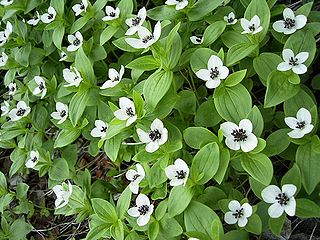
The Cornaceae are a cosmopolitan family of flowering plants in the order Cornales. The family contains approximately 85 species in two genera, Alangium and Cornus. They are mostly trees and shrubs, which may be deciduous or evergreen, although a few species are perennial herbs. Members of the family usually have opposite or alternate simple leaves, four- or five-parted flowers clustered in inflorescences or pseudanthia, and drupaceous fruits. The family is primarily distributed in northern temperate regions and tropical Asia. In northern temperate areas, Cornaceae are well known from the dogwoods Cornus.

Ceratophyllaceae is a cosmopolitan family of flowering plants including one living genus commonly found in ponds, marshes, and quiet streams in tropical and in temperate regions. It is the only extant family in the order Ceratophyllales. Species are commonly called coontails or hornworts, although hornwort is also used for unrelated plants of the division Anthocerotophyta.

Petrosaviaceae is a family of flowering plants belonging to a monotypic order, Petrosaviales. Petrosaviales are monocots, and are grouped within the lilioid monocots. Petrosaviales is a very small order composed of one family, two genera and four species accepted in 2016. Some species are photosynthetic (Japonolirion) and others are rare, leafless, chlorophyllous, mycoheterotrophic plants (Petrosavia). The family is found in low-light montane rainforests in Japan, China, Southeast Asia and Borneo. They are characterised by having bracteate racemes, pedicellate flowers, six persistent tepals, septal nectaries, three almost-distinct carpels, simultaneous microsporogenesis, monosulcate pollen, and follicular fruit.

Nartheciaceae is a family of flowering plants. The APG III system places it in the order Dioscoreales, in the clade monocots. As circumscribed by APG IV (2016) it includes 35 species of herbaceous plants in the following five genera:
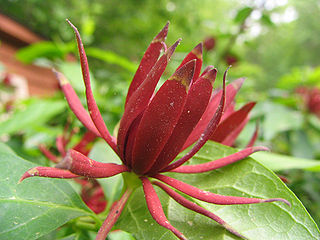
The Calycanthaceae are a small family of flowering plants in the order Laurales. The family contains three genera and only 10 known species, restricted to warm temperate and tropical regions:
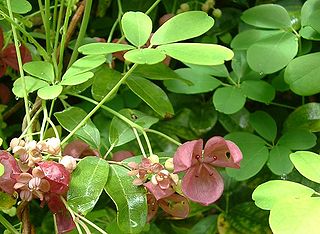
Lardizabalaceae is a family of flowering plants.

Juncaginaceae is a family of flowering plants, recognized by most taxonomists for the past few decades. It is also known as the arrowgrass family. It includes 3 genera with a total of 34 known species.

Chloranthaceae is a family of flowering plants (angiosperms), the only family in the order Chloranthales. It is not closely related to any other family of flowering plants, and is among the early-diverging lineages in the angiosperms. They are woody or weakly woody plants occurring in Southeast Asia, the Pacific, Madagascar, Central and South America, and the West Indies. The family consists of four extant genera, totalling about 77 known species according to Christenhusz and Byng in 2016. Some species are used in traditional medicine. The type genus is Chloranthus. The fossil record of the family, mostly represented by pollen such as Clavatipollenites, extends back to the dawn of the history of flowering plants in the Early Cretaceous, and has been found on all continents.

Erythroxylaceae is a family of flowering trees and shrubs consisting of 4 genera and 271 species. The four genera are AneulophusBenth., ErythroxylumP.Browne, NectaropetalumEngl., and PinacopodiumExell & Mendonça. The best-known species are the coca plants, including the species Erythroxylum coca, the source of the substance coca.

Peridiscaceae is a family of flowering plants in the order Saxifragales. Four genera comprise this family: Medusandra, Soyauxia, Peridiscus, and Whittonia., with a total of 12 known species. It has a disjunct distribution, with Peridiscus occurring in Venezuela and northern Brazil, Whittonia in Guyana, Medusandra in Cameroon, and Soyauxia in tropical West Africa. Whittonia is possibly extinct, being known from only one specimen collected below Kaieteur Falls in Guyana. In 2006, archeologists attempted to rediscover it, however, it proved unsuccessful.

Berberidopsidaceae is a family of flowering plants. Such a family has only recently been recognized by more than a few taxonomists: the plants involved have often been treated as belonging to family Flacourtiaceae.
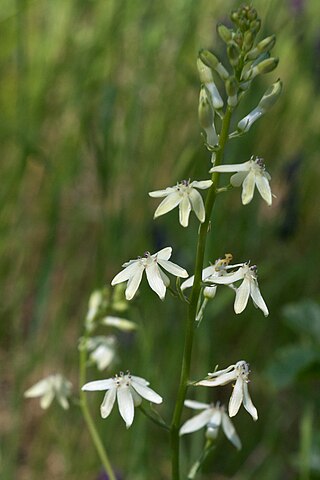
Tecophilaeaceae is a family of flowering plants, placed in the order Asparagales of the monocots. It consists of nine genera with a total of 27 species.

Salvadoraceae is a family in the plant order Brassicales, consisting of three genera with a total of 11 known species. They occur in Africa, Southeast Asia, and on Java, suggesting they are probably found in much of Malesia. They are often found in hot, dry areas.

Gyrostemonaceae is a family of plants in the order Brassicales. It comprises 4(-6) genera, totalling about 20 known species. All are endemic to temperate parts of Australia. They are shrubs or small trees with small, often narrow leaves, and small flowers. They are wind-pollinated.
Diplopanax is a genus of flowering trees placed in the family Cornaceae or Nyssaceae. Its two known extant species inhabit the wet tropical mountains of Vietnam and southern China. They are broad-leaved evergreen trees with woody fruits and white or yellow flowers.

Hydrostachys is a genus of about 22 species of flowering plants native to Madagascar and southern and central Africa. It is the only genus in the family Hydrostachyaceae. All species of Hydrostachys are aquatic, growing on rocks in fast-moving water. They have tuberous roots, usually pinnately compound leaves, and highly reduced flowers on dense spikes.

Huaceae is a family of plant in the rosids group, which has been classed in the orders Malpighiales, Malvales, and Violales or in its own order Huales. The APG II system placed it in the clade eurosids I, whereas the APG III system of 2009 and APG IV (2016) place it within the Oxalidales. The family is endemic to central Africa. It contains four species in the following two genera:
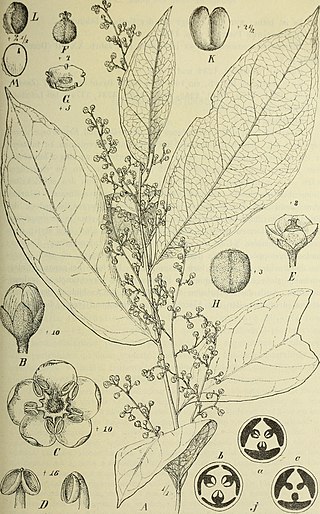
Centroplacaceae is a family of flowering plants in the order Malpighiales and is recognized by the APG III system of classification. The family comprises two genera: Bhesa, which was formerly recognized in the Celastraceae, and Centroplacus, which was formerly recognized in the Euphorbiaceae, together comprising six species. The Angiosperm Phylogeny Group determined that based on previous phylogenetic analysis, these two genera formed an isolated clade and recognition of the family was "reasonable."

Metteniusaceae are a family of flowering plants, the only family in the order Metteniusales. It consists of about 10 genera and 50 species of trees, shrubs, and lianas, primarily of the tropics. The family was formerly restricted to just Metteniusa, but it is now expanded with a number of genera that were formerly placed in the widely polyphyletic Icacinaceae.



















